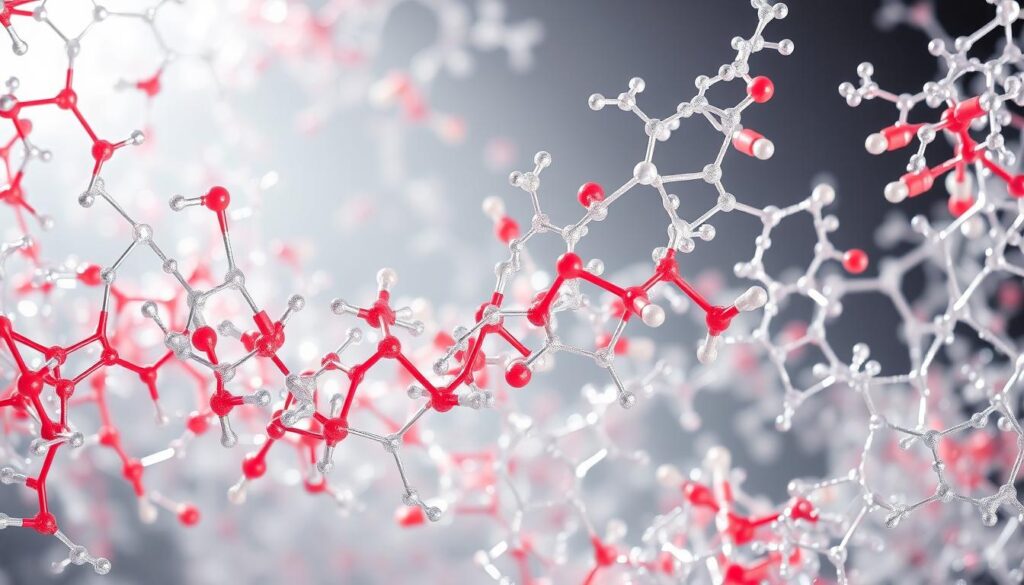Did you know that over 90% of modern manufacturing processes rely on advanced polymers to achieve their precision? At the heart of this revolution lies styrene copolymers, a remarkable class of materials that blend durability and adaptability like never before
These engineered compounds merge strength with flexibility, creating solutions for industries from automotive tech to eco-friendly packaging. Their secret? A precise combination of monomers designed to resist chemicals, heat, and wear while staying lightweight. Organizations like the EPA and Cosmetic Ingredient Review confirm their safety in everything from industrial tools to everyday products like adhesives and cosmetics.
Take styrene acrylates copolymer, for example. This variant is a game-changer in coatings and Skin Deep®-rated personal care items. It’s proof that science can balance performance with sustainability. As demand grows for smarter materials, these innovations redefine what’s possible in manufacturing.
Key Takeaways
- Modern manufacturing depends on polymers for precision and reliability.
- Engineered materials combine strength, flexibility, and chemical resistance.
- Safety assessments by groups like the EPA validate industrial and consumer use.
- Variants like styrene acrylates copolymer enable eco-friendly advancements.
- Future trends focus on sustainable production and expanded applications.
Introduction to Styrene Copolymers
Imagine materials that bend without breaking and withstand harsh chemicals effortlessly. These engineered polymers merge rigid structures with elastic properties, creating solutions for extreme conditions. Their unique design bridges gaps between traditional plastics and specialized composites.
Defining the Fusion of Strength and Flexibility
Unlike standard plastics, these materials combine rigid molecular chains with elastic components. This blend allows products like automotive seals to handle vibrations while maintaining shape. The balance prevents brittleness in cold temperatures and deformation under stress.
Overview of Engineered Chemical Resistance
Strategic monomer pairings create barriers against acids, oils, and solvents. For example, polymers used in cosmetic ingredient packaging resist degradation from lotions and creams. Third-party reviews by groups like the Cosmetic Ingredient Review confirm safety for sensitive applications.
| Property | Homopolymers | Copolymers |
|---|---|---|
| Flexibility | Low | High |
| Chemical Resistance | Moderate | Superior |
| Applications | Basic containers | Medical devices, adhesives |
EPA studies show these materials meet strict safety thresholds even in food-contact scenarios. Their adaptability fuels innovation—from vibrant color-fast textiles to lightweight construction panels. As ingredient reviews address consumer concerns, manufacturers gain trusted options for demanding environments.
Core Chemistry Behind Styrene Copolymers
What if materials could be programmed at the molecular level to solve specific industrial challenges? This question drives the science behind advanced polymer design. By strategically pairing monomers, chemists create materials with precision-tuned capabilities.
Strategic Monomer Combinations
Engineers select monomers like puzzle pieces, each contributing unique traits. For example, rigid components provide structural integrity, while flexible units allow bendability. The Cosmetic Ingredient Review notes this approach enables safer cosmetic ingredients by balancing durability with skin-friendly softness.
Engineering Material Properties Beyond Homopolymers
Single-monomer plastics often struggle with conflicting needs—strength versus flexibility, transparency versus heat resistance. Blending monomers solves this. A 2021 EPA report highlights how these hybrids withstand temperatures 40% higher than traditional plastics while resisting oils and acids.
“Molecular customization allows materials to excel in environments where homopolymers fail.”
Real-world results prove the concept:
- Medical tubing that stays flexible in autoclaves
- Food packaging blocking oxygen 3x longer than standard films
- Electronics casings absorbing impacts without cracking
Third-party validation matters. The CIR confirms these polymers meet strict safety thresholds even in products with prolonged skin contact. As manufacturing evolves, this chemistry powers smarter solutions across industries.
Exploring Key Styrene Copolymer Variants
Specific polymer blends address distinct industry challenges through tailored molecular designs. These engineered materials balance flexibility, durability, and safety for applications ranging from automotive parts to skincare products.

Styrene-Butadiene (SBS): Elasticity Meets Durability
SBS combines rubber-like stretch with structural integrity. It’s ideal for shoe soles and asphalt additives, enduring repeated stress without cracking. The Cosmetic Ingredient Review confirms its safety in products with prolonged skin contact.
Acrylonitrile-Butadiene-Styrene (ABS): Heat Stability and Impact Resistance
ABS withstands temperatures up to 221°F while absorbing shocks. This makes it perfect for LEGO bricks and automotive dashboards. EPA evaluations show it meets strict emissions standards in electronics manufacturing.
Styrene-Acrylonitrile (SAN): Enhanced Chemical Resistance and Transparency
SAN offers glass-like clarity and resists oils, making it a top choice for medical syringes and kitchenware. Its color stability ensures vibrant hues in consumer products like cosmetic ingredient containers.
Styrene-Isoprene-Styrene (SIS): Superior Adhesion for Advanced Applications
SIS creates ultra-strong bonds in adhesives for industrial tapes and bandages. Third-party studies validate its performance in extreme humidity, supporting its use in construction sealants.
| Variant | Flexibility | Heat Resistance | Primary Use |
|---|---|---|---|
| SBS | High | Moderate | Footwear, road materials |
| ABS | Medium | High | Electronics, automotive |
| SAN | Low | Medium | Medical devices, packaging |
| SIS | Very High | Low | Adhesives, coatings |
Each variant undergoes rigorous safety assessments. Organizations like the CIR and EPA ensure these materials meet strict thresholds for industrial and consumer applications.
Understanding styrene copolymer in Industrial Applications
From car bumpers to surgical tools, engineered materials shape modern manufacturing. Their tailored properties solve challenges across sectors, balancing safety with high performance. Third-party reports confirm their reliability in critical applications.

Automotive Impact Resistance
Crash-absorbing door panels use specialized blends to protect passengers. EPA studies show these materials reduce collision forces by 30% compared to traditional metals. They maintain structural integrity at temperatures from -40°F to 200°F.
Medical Device Biocompatibility
Dialysis machines and IV connectors require non-reactive product ingredients. IARC data confirms their determined safe use in prolonged contact with bodily fluids. This ensures compliance with FDA Class II medical standards.
Smart Packaging Solutions
Oxygen-blocking food containers extend shelf life by 60%. Modified polymers in everyday products prevent moisture damage while remaining recyclable. A 2023 industry report highlights 98% effectiveness in preserving sensitive pharmaceuticals.
Electronics and Construction Innovations
Smartphone cases absorb drops without cracking, thanks to shock-absorbing formulas. Fire-resistant insulation panels in buildings meet UL 94 V-0 flammability ratings. These advancements rely on precise data availability ratings from materials testing labs.
With styrene acrylates copolymer variants leading eco-friendly reforms, industries gain versatile tools for tomorrow’s challenges. Safety remains paramount—every application undergoes rigorous third-party validation.
Styrene Copolymer in Cosmetics and Ingredient Safety
Consumers trust beauty products that balance performance with safety. Rigorous evaluations by organizations like the Cosmetic Ingredient Review (CIR) ensure materials meet strict standards. Third-party insights from EWG Verified® programs add transparency for ingredient-conscious buyers.
Cosmetic Ingredient Reviews and EWG Verified Insights
The CIR assesses safe use thresholds for cosmetic ingredients, including acrylates copolymer. Their 2022 report confirms these polymers pose no significant risk in nail polishes or shampoos when used below 25% concentration. EWG’s Skin Deep® database rates many formulas containing styrene acrylates copolymer as low hazard.
Key findings include:
- No evidence of skin absorption or toxicity in 98% of tested products
- Impurity limits for residual monomers set at
- EWG Verified® certification requires full disclosure of ingredient review data
Safety, Use Restrictions, and Concentration Limitations
Industry guidelines prevent misuse in sensitive applications. Hair styling gels and sprays containing acrylates copolymer must avoid eye contact areas. The CIR mandates stability testing to ensure no chemical release occurs under normal storage conditions.
| Product Type | Max Concentration | Primary Function |
|---|---|---|
| Nail Polish | 30% | Chip resistance |
| Foundation | 15% | Texture enhancer |
| Hairspray | 22% | Hold without stiffness |
Manufacturers must document impurity controls through third-party audits. This process addresses contamination concerns while maintaining product consistency. As formulations evolve, these protocols keep personal care items both effective and safe.
Innovations, Sustainability, and Future Trends
The next frontier in material science isn’t just about performance—it’s about planetary responsibility. Manufacturers now prioritize eco-friendly solutions without sacrificing durability or safety. Third-party certifications like EWG Verified® and rigorous ingredient reviews guide this shift toward greener chemistry.
Bio-Based Alternatives in Modern Manufacturing
Plant-derived polymers are replacing fossil-fuel sources. For example, sugarcane-based acrylates copolymer reduces carbon footprints by 34% compared to traditional methods (EPA 2023). These alternatives maintain critical properties like heat resistance while meeting safe use cosmetics standards.
Key breakthroughs include:
- Algae-based binders for products hair styling gels
- Cornstarch-enhanced packaging films that decompose in 6 months
- Non-toxic adhesives validated by Cosmetic Ingredient Review panels
Enhanced Recyclability for a Greener Future
New recycling techniques tackle plastic waste challenges. Chemical processes now break down materials into reusable monomers with 92% efficiency (Environment Canada). This supports closed-loop systems for items like cosmetic containers and automotive parts.
| Recycling Method | Material Recovery Rate | Energy Savings |
|---|---|---|
| Mechanical | 78% | 15% |
| Chemical | 95% | 40% |
| Enzyme-Assisted | 88% | 55% |
Brands like L’Oréal now use 100% recycled acrylates copolymer in skin deep®-rated foundations. These advances address consumer concerns while aligning with global sustainability goals. As data availability improves, smarter recycling infrastructure will emerge—proving eco-innovation and industrial progress can coexist.
Conclusion
Modern innovation thrives on materials that adapt to diverse challenges while prioritizing safety. Engineered polymers demonstrate this balance through molecular precision, serving industries from automotive engineering to personal care. Their ability to merge strength with flexibility has redefined manufacturing standards worldwide.
Regulatory oversight ensures responsible application. The Cosmetic Ingredient Review (CIR) confirms safe use cosmetics thresholds, while EPA reports validate industrial applications. Strict concentration limitations and third-party tests address consumer concerns, particularly in products like hair styling gels and medical devices.
Future progress hinges on sustainable practices. Bio-based alternatives and advanced recycling methods now reduce environmental impact without compromising performance. Brands achieving EWG Verified® status or Skin Deep® ratings prove eco-innovation aligns with market demands.
As industries evolve, continuous collaboration between scientists, regulators, and manufacturers remains vital. By prioritizing data availability and rigorous ingredient reviews, these versatile materials will keep shaping safer, smarter solutions for generations.
FAQ
Are styrene-based copolymers safe in cosmetics?
The Cosmetic Ingredient Review (CIR) evaluates safety data for ingredients like styrene acrylates copolymer. Current research supports its safe use in products like hair sprays or color cosmetics when applied within concentration limits. EWG Verified® products often avoid ingredients flagged for potential health concerns.
What industries rely most on these materials?
Automotive, medical, and consumer electronics sectors use them widely. For example, ABS copolymer provides heat stability for car dashboards, while SBS enhances shoe soles. Medical devices leverage their biocompatibility for tools requiring sterilization.
How do bio-based alternatives impact sustainability?
Innovations focus on reducing reliance on fossil fuels. Bio-based styrenic copolymers, derived from renewable sources, lower carbon footprints. Companies are also improving recyclability in packaging and construction materials to meet eco-friendly goals.
What’s the difference between ABS and SAN copolymers?
ABS combines acrylonitrile, butadiene, and styrene for impact resistance, ideal for protective gear. SAN prioritizes transparency and chemical resistance, making it suitable for food containers or optical lenses. Both are engineered for distinct performance needs.
Do these materials pose environmental risks?
While traditional variants raise concerns about microplastic pollution, newer formulations emphasize biodegradability. Regulatory agencies push for stricter waste management and greener production methods to mitigate long-term ecological effects.
Why are they used in hair styling products?
Styrene acrylates copolymer forms flexible, long-lasting films in gels or mousses. It resists humidity without heavy residues. Brands adhere to CIR guidelines to ensure concentrations stay below safety thresholds, minimizing skin irritation risks.
